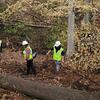View national media coverage of our activities here.
Field stations are living laboratories for hands-on and field-based experiences, and they can also provide powerful opportunities to conduct cutting-edge research and train students on our most pressing environmental challenges.
The Temple Ambler Field Station established the Temple Forest Observatory in collaboration with the Smithsonian Institution Forest Global Earth Observatory (ForestGEO ) as a platform for integrated research and training and to promote diversity in the sciences. Remarkably, after detailed data on more than 4,500 woody stems had been collected by students and other scientists following standardized ForestGEO protocols, the Temple Forest Observatory was struck by a destructive EF-2 tornado resulting from Hurricane Ida merging with a non-tropical front on September 1, 2021.
While this large-scale climate-driven disturbance served to remind us of one of the many symptoms of climate change, there is opportunity in recovery. We are leveraging this event and detailed pre- and post-storm data to investigate ecosystem resilience to a novel but increasingly relevant type of disturbance in forests in the northeastern US, and to provide a diversity of students with a powerful interdisciplinary opportunity to study the impacts of climate change right in suburban Philadelphia.
While ensuring the safety of our team to conduct field work in a highly disturbed forest, students are engaging in a detailed assessment of woody plant survival after the tornado. This activity provides not only a critical post-storm dataset, but also a unique experience for students to study the impacts of this severe disturbance on, for example, carbon pools, patterns of species diversity, survival of dominant trees, and wildlife foraging activity.
Through collaborations with researchers from Temple and other universities, we are beginning new lines of investigation to understand the impacts of the storm on ecosystem services that benefit society, geological processes within the forest, and tree demography. Further, we are documenting the impacts of the storm on biodiversity, both losses and gains, as we work to expand the list of 35 bird species and 20 mammal species that are known to live in downed trees.
We further established a new field-based course in Disturbance Ecology, educational modules for other courses, and site visits that have challenged high school and college students to think critically about climate-driven disturbances through the lens of different disciplines, including biology, environmental sciences, geology, geography and urban studies, public health, architecture, and social science.
In a world where changes are happening at unprecedent rates, expanding knowledge and providing students with field-based experiences that integrate across disciplines will be critical to preparing this and future generations for tackling the urgent challenge of climate change.
Please note that the Temple Forest Observatory is closed to the public due to safety concerns and the preservation of this site as a platform for research and training. Anyone who would like to use the Observatory for research or educational purposes should submit a request via our online form . Someone from the Field Station will then contact you to discuss your needs and to provide a safety training.

